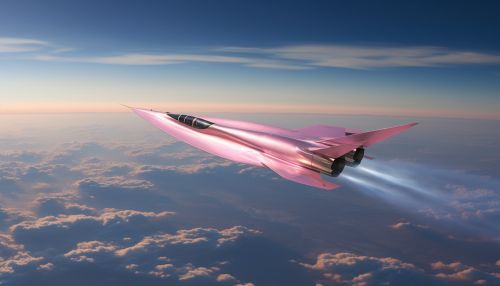Hypersonic Flight Physics
Introduction
Hypersonic flight, a term coined in the mid-20th century, refers to the phenomenon of flight at speeds greater than Mach 5, or five times the speed of sound. This speed regime is characterized by unique physical phenomena that are not typically encountered in subsonic, transonic, or supersonic flight. These phenomena include shock wave interactions, high-temperature effects, and reentry dynamics, among others.


Physics of Hypersonic Flight
The physics of hypersonic flight are complex and multifaceted, involving several interrelated phenomena. At hypersonic speeds, the aerodynamic forces acting on an aircraft are significantly different from those at lower speeds. The primary physical phenomena that characterize hypersonic flight are discussed in the following sections.
Shock Waves
At hypersonic speeds, an aircraft generates strong shock waves that propagate ahead of it. These shock waves are essentially pressure waves that form when an aircraft travels faster than the speed of sound. The shock waves can interact with each other and with the boundary layer of the aircraft, leading to complex flow patterns and potentially high aerodynamic heating rates.
High-Temperature Effects
When an aircraft travels at hypersonic speeds, the air in front of it is compressed and heated to very high temperatures. This can lead to a number of high-temperature effects, including thermal radiation, chemical reactions, and ionization of the air. These effects can have a significant impact on the aerodynamics and structural integrity of the aircraft.
Reentry Dynamics
Reentry dynamics are a critical aspect of hypersonic flight, particularly for spacecraft returning to Earth. During reentry, a spacecraft experiences extreme aerodynamic heating due to the compression and friction of the air. This can lead to the formation of a hot plasma around the spacecraft, which can interfere with communication systems and potentially damage the spacecraft.
Hypersonic Aerodynamics
The aerodynamics of hypersonic flight are significantly different from those of subsonic or supersonic flight. At hypersonic speeds, the flow of air around an aircraft is dominated by shock waves and high-temperature effects, which can have a significant impact on the aircraft's lift, drag, and stability.
Lift and Drag
At hypersonic speeds, the lift-to-drag ratio of an aircraft is typically much lower than at lower speeds. This is due to the strong shock waves and high aerodynamic heating rates, which can significantly increase the drag. However, with the right design and materials, it is possible to achieve a favorable lift-to-drag ratio even at hypersonic speeds.
Stability and Control
The stability and control of an aircraft at hypersonic speeds can be a significant challenge. The strong shock waves and high-temperature effects can lead to large changes in the aerodynamic forces and moments acting on the aircraft, which can make it difficult to maintain stable flight. Advanced control systems and flight control surfaces are typically required to ensure stability and control at hypersonic speeds.
Hypersonic Propulsion
The propulsion systems used for hypersonic flight are typically different from those used for subsonic or supersonic flight. The most common types of hypersonic propulsion systems are scramjets and rocket engines.
Scramjets
Scramjets, or supersonic combustion ramjets, are a type of air-breathing engine that can operate at hypersonic speeds. They work by compressing incoming air before combustion, but unlike traditional jet engines, the air is not slowed down to subsonic speeds before combustion. This allows scramjets to operate efficiently at hypersonic speeds.
Rocket Engines
Rocket engines are another common type of propulsion system used for hypersonic flight. They work by expelling high-speed exhaust gases to generate thrust. Rocket engines do not require an external air supply, which makes them suitable for use in space.
Challenges and Future Directions
Despite significant advancements in the field of hypersonic flight, there are still many challenges to be overcome. These include the development of materials that can withstand the high temperatures and pressures of hypersonic flight, the design of efficient hypersonic propulsion systems, and the understanding and mitigation of the environmental impacts of hypersonic flight.
